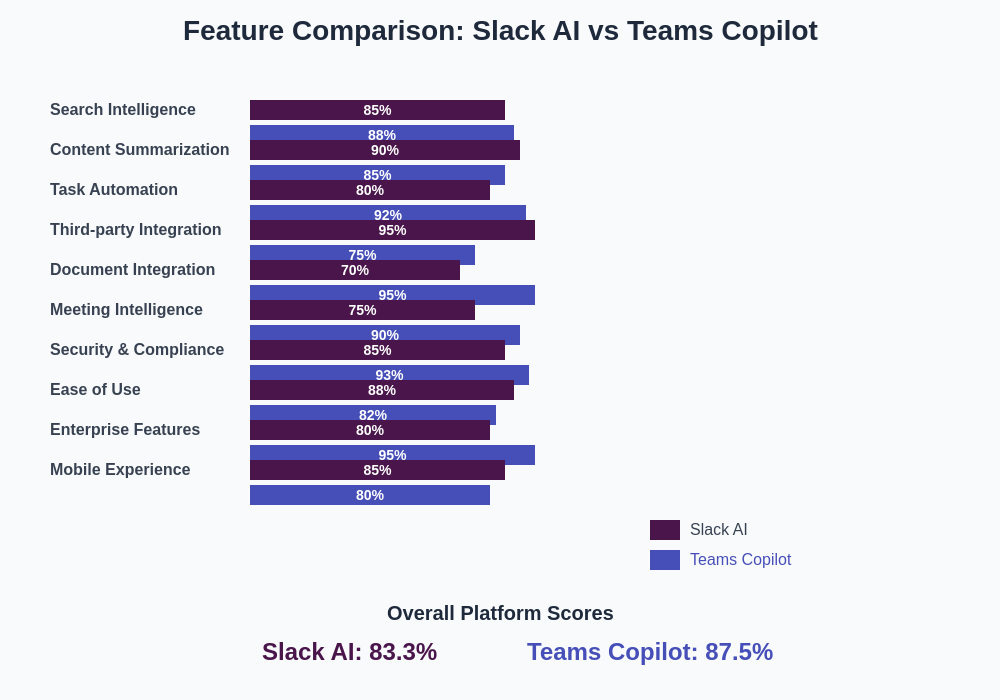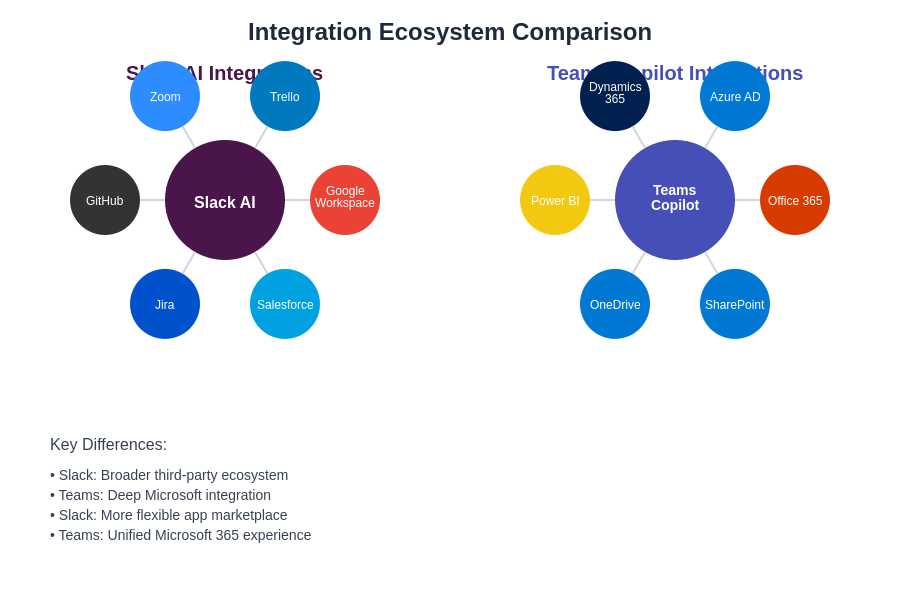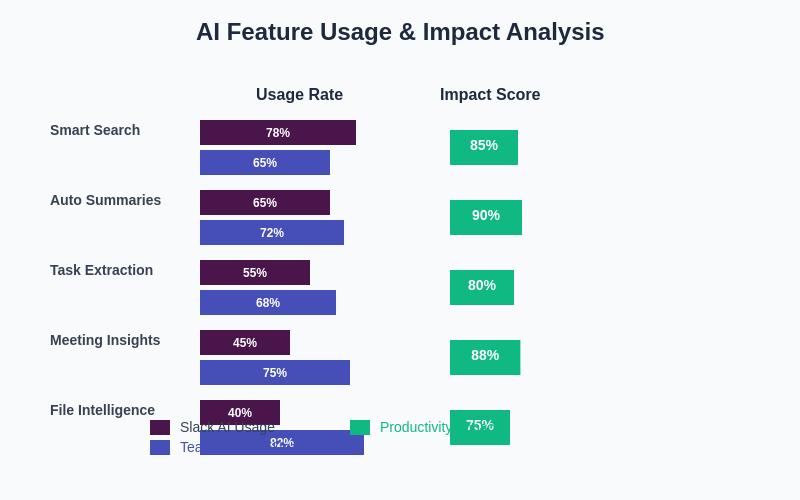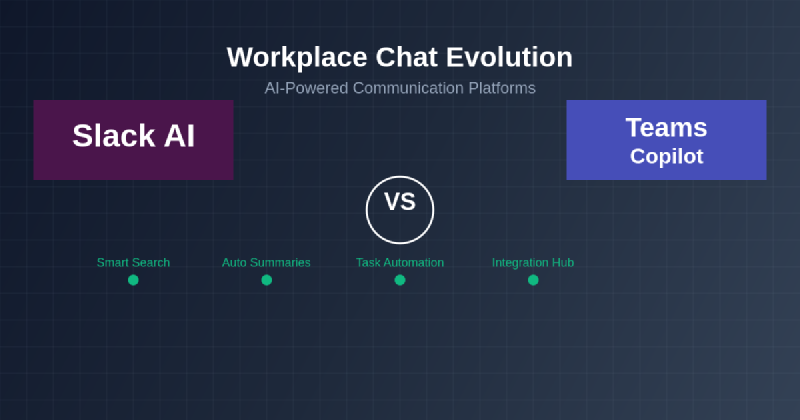The modern workplace has witnessed an unprecedented transformation in communication technology, with artificial intelligence fundamentally reshaping how teams collaborate, share information, and maintain productivity across distributed work environments. At the epicenter of this revolution stand two dominant platforms that have evolved beyond simple messaging tools to become comprehensive AI-powered collaboration ecosystems: Slack with its advanced AI capabilities and Microsoft Teams with its integrated Copilot functionality. This evolution represents more than just feature enhancement; it signifies a complete reimagining of workplace communication paradigms.
Explore the latest workplace AI trends to understand how artificial intelligence is continuously transforming professional communication and collaboration methodologies. The integration of sophisticated AI assistants into these platforms has created new possibilities for automating routine tasks, enhancing decision-making processes, and facilitating more meaningful human connections in increasingly digital work environments.
The Foundation of Modern Workplace AI
The emergence of AI-enhanced communication platforms represents a natural evolution from traditional chat applications to intelligent collaboration hubs that understand context, anticipate needs, and proactively assist teams in achieving their objectives. Both Slack AI and Microsoft Teams Copilot have been designed with the understanding that modern workplace communication extends far beyond simple message exchange to encompass knowledge management, task coordination, project tracking, and strategic decision support.
Slack AI has positioned itself as a comprehensive intelligence layer that seamlessly integrates across all platform interactions, offering capabilities such as automated summarization of conversations, intelligent search functionality that understands context and intent, and proactive insights that help teams identify trends, bottlenecks, and opportunities for improvement. The platform’s AI capabilities extend to workflow automation, where routine processes can be intelligently managed and optimized based on historical patterns and user behavior analysis.
Microsoft Teams Copilot, leveraging the robust foundation of Microsoft’s broader AI ecosystem, provides deep integration with the entire Microsoft 365 suite, enabling users to access intelligent assistance not only within chat interactions but also across documents, presentations, spreadsheets, and other productivity applications. This comprehensive approach creates a unified AI experience that spans the entire digital workspace, allowing for seamless transitions between communication, document creation, data analysis, and project management activities.

The comprehensive feature analysis reveals distinct strengths and positioning strategies for each platform, with Slack AI excelling in third-party integrations and ease of use, while Teams Copilot demonstrates superior performance in enterprise features and Microsoft ecosystem integration.
Interface Design and User Experience Philosophy
The user experience philosophy underlying each platform reflects distinctly different approaches to integrating artificial intelligence into workplace communication workflows. Slack AI emphasizes contextual intelligence that operates primarily in the background, surfacing relevant information and suggestions at precisely the right moments without disrupting natural conversation flow. This approach prioritizes user agency and maintains the platform’s characteristic simplicity while adding layers of intelligence that enhance rather than replace human decision-making processes.
The interface design philosophy centers around making AI capabilities discoverable yet unobtrusive, ensuring that users can access advanced functionality when needed while preserving the intuitive communication experience that has made Slack a workplace standard. Features such as thread summarization, channel insights, and automated task extraction are presented as natural extensions of existing workflows rather than separate AI tools requiring distinct interaction patterns.
Microsoft Teams Copilot adopts a more prominent integration approach, positioning the AI assistant as a visible and active participant in workplace conversations and activities. The interface design emphasizes the AI’s role as a collaborative partner, with dedicated interaction spaces, prominent suggestion mechanisms, and integrated AI-powered features that encourage regular engagement. This approach reflects Microsoft’s broader strategy of making AI assistance a central component of the productivity experience rather than a supplementary feature.
Discover advanced AI workplace solutions with Claude to enhance your team’s collaboration and productivity through intelligent automation and contextual assistance. The integration of AI into workplace communication platforms represents just the beginning of a broader transformation that will continue to evolve as artificial intelligence capabilities become more sophisticated and deeply integrated into professional workflows.
Content Intelligence and Conversation Management
The approach to content intelligence and conversation management reveals fundamental differences in how each platform conceptualizes the role of AI in workplace communication. Slack AI excels in understanding conversational context, identifying key decisions, action items, and important information buried within lengthy discussion threads. The platform’s AI capabilities include sophisticated natural language processing that can distinguish between casual conversation, formal decisions, task assignments, and knowledge sharing, automatically categorizing and surfacing relevant content based on individual user needs and team priorities.
The conversation management features extend to intelligent notification systems that understand urgency, relevance, and user preferences to reduce information overload while ensuring critical communications receive appropriate attention. Slack AI can analyze conversation patterns to identify when discussions are becoming circular, when consensus is emerging, or when additional participants might need to be included to move conversations forward effectively.
Microsoft Teams Copilot approaches content intelligence through the lens of document and data integration, leveraging the platform’s deep connection with Microsoft 365 applications to provide contextual insights that span multiple information sources. The AI can analyze not only chat conversations but also related documents, calendar events, email exchanges, and project data to provide comprehensive context and intelligent recommendations for next actions.
This integrated approach enables Teams Copilot to offer suggestions that consider the broader context of work activities, such as recommending relevant documents during discussions, suggesting meeting times based on participant availability and workload, or identifying potential conflicts between project timelines and resource availability. The AI’s ability to synthesize information from multiple sources creates opportunities for insights that individual application-focused AI systems cannot provide.
Workflow Automation and Task Management
The automation capabilities of both platforms reflect different philosophies regarding the role of AI in managing workplace workflows and task coordination. Slack AI focuses on intelligent workflow detection and automation suggestions, analyzing team communication patterns to identify repetitive processes that could benefit from automation. The platform can recognize common request patterns, approval workflows, and information sharing routines, then suggest or automatically implement streamlined processes that reduce manual coordination overhead.
The task management intelligence extends to project tracking, where Slack AI can monitor project-related conversations across multiple channels to provide automated status updates, identify potential delays, and suggest resource reallocation strategies. This capability is particularly valuable for distributed teams where project coordination relies heavily on asynchronous communication and informal status sharing.
Microsoft Teams Copilot leverages its integration with Microsoft Project, Planner, and other productivity tools to provide comprehensive task management automation that spans multiple applications and data sources. The AI can automatically create tasks based on conversation content, assign responsibilities based on expertise and availability analysis, and track progress across multiple project management systems while providing intelligent insights about resource utilization and project timeline optimization.
The automation capabilities extend to meeting management, where Teams Copilot can automatically schedule follow-up meetings, create action item lists, distribute meeting summaries, and track completion of assigned tasks across subsequent conversations and document collaborations. This comprehensive approach to workflow automation creates seamless transitions between communication, planning, and execution phases of project work.
Integration Ecosystem and Third-Party Connectivity
The approach to third-party integrations and ecosystem connectivity reveals strategic differences in how each platform positions itself within the broader landscape of workplace technology tools. Slack AI maintains its traditional strength in third-party integrations while enhancing these connections with intelligent automation and context awareness. The platform can intelligently route information between connected applications, automatically update relevant systems based on conversation content, and provide consolidated insights from multiple data sources without requiring manual coordination.
The AI-enhanced integration ecosystem includes intelligent data synchronization, where changes in one connected system can automatically trigger updates in relevant channels, notify appropriate team members, and suggest follow-up actions based on the nature of the changes. This capability transforms Slack from a simple communication hub into an intelligent coordination platform that actively manages information flow across the entire technology stack.
Microsoft Teams Copilot benefits from deep native integration with the Microsoft ecosystem while also supporting connections to external platforms through its extensive API and connector framework. The AI’s ability to leverage Microsoft Graph data creates opportunities for intelligent insights that span email, calendar, documents, and chat interactions, providing comprehensive context that external integrations cannot easily replicate.
The integration approach emphasizes creating unified experiences where AI assistance remains consistent across different applications and data sources, enabling users to access intelligent help regardless of which Microsoft application they are currently using. This consistency creates a more cohesive user experience but may limit flexibility for organizations heavily invested in non-Microsoft technology stacks.

The integration ecosystem comparison illustrates the fundamental philosophical differences between platforms, with Slack AI emphasizing broad third-party connectivity and Teams Copilot focusing on deep Microsoft ecosystem integration to create seamless productivity workflows.
Enhance your research and analysis capabilities with Perplexity to gather comprehensive information about workplace technology trends and make informed decisions about platform selection and implementation strategies. The choice between different AI-enhanced collaboration platforms requires careful consideration of existing technology investments, team preferences, and long-term strategic objectives.
Search Intelligence and Knowledge Discovery
The implementation of intelligent search capabilities demonstrates how each platform approaches the challenge of knowledge discovery in increasingly complex workplace communication environments. Slack AI has developed sophisticated search intelligence that understands natural language queries, contextual relationships between conversations, and user intent to provide highly relevant results even when specific keywords are not used. The AI can interpret queries like “what did we decide about the budget last month” and surface relevant conversations, decisions, and follow-up actions across multiple channels and timeframes.
The knowledge discovery capabilities extend to proactive information surfacing, where Slack AI can identify when current conversations relate to previous discussions, decisions, or shared resources, automatically suggesting relevant context that might inform current decision-making processes. This capability is particularly valuable for onboarding new team members or bringing participants up to speed on ongoing projects and discussions.
Microsoft Teams Copilot leverages Microsoft’s extensive experience in enterprise search to provide intelligent knowledge discovery that spans not only chat conversations but also documents, emails, calendar events, and other Microsoft 365 content. The AI can understand complex queries that reference multiple types of content and provide consolidated results that show relationships between different information sources.
The search intelligence includes semantic understanding that can identify conceptual relationships even when exact terminology differs, making it easier to find relevant information in large organizations where different teams may use varying terminology for similar concepts. This capability is enhanced by the AI’s ability to learn from user behavior and continuously improve search relevance based on what information proves most useful in different contexts.
Privacy, Security, and Compliance Considerations
The handling of privacy, security, and compliance requirements represents a critical differentiator for organizations evaluating AI-enhanced communication platforms. Slack AI implements comprehensive privacy protection measures that ensure AI processing respects user permissions, channel access controls, and organizational data governance policies. The platform’s approach to AI privacy includes transparent data usage policies, user control over AI feature engagement, and robust encryption of all AI-processed content.
The compliance capabilities include industry-specific features that ensure AI assistance operates within regulatory requirements for sectors such as healthcare, finance, and government, where communication content may be subject to specific retention, access, and processing restrictions. Slack AI provides detailed audit logs of AI interactions, enabling organizations to maintain compliance with various regulatory frameworks while still benefiting from intelligent assistance.
Microsoft Teams Copilot benefits from Microsoft’s extensive compliance framework and enterprise security infrastructure, providing AI assistance that operates within the comprehensive security and compliance boundaries of the Microsoft 365 ecosystem. The platform includes advanced data loss prevention capabilities that prevent AI systems from inadvertently exposing sensitive information through suggestions or automated actions.
The enterprise-grade security features include conditional access policies that can restrict AI functionality based on user roles, device compliance, or network location, ensuring that sensitive AI capabilities are only available to authorized users under appropriate circumstances. This granular control enables organizations to customize AI assistance based on specific security requirements while maintaining productivity benefits for authorized users.
Performance Analytics and Usage Insights
The analytical capabilities provided by each platform offer valuable insights into how AI assistance impacts team productivity, communication effectiveness, and overall workplace collaboration outcomes. Slack AI provides comprehensive analytics that help administrators understand how AI features are being utilized, which capabilities provide the most value, and where additional training or feature adoption might improve team productivity.
The performance insights include metrics such as time saved through automated summarization, improved search efficiency, and reduced information seeking overhead, enabling organizations to quantify the return on investment from AI-enhanced communication tools. These analytics also help identify usage patterns that might indicate opportunities for additional automation or workflow optimization.
Microsoft Teams Copilot offers detailed usage analytics integrated with the broader Microsoft 365 productivity insights, providing a comprehensive view of how AI assistance impacts overall workplace productivity across multiple applications and workflows. The analytics include cross-application insights that show how AI assistance in Teams correlates with productivity improvements in other Microsoft applications.
The comprehensive analytical framework enables organizations to understand not just how AI features are being used but also their impact on broader business outcomes such as project completion rates, meeting effectiveness, and knowledge sharing efficiency. This holistic view of AI impact helps justify continued investment in AI-enhanced collaboration tools and guides future platform optimization strategies.

The usage analytics reveal varying adoption patterns across different AI features, with smart search and auto-summarization showing the highest usage rates and productivity impact, while more specialized features like meeting insights demonstrate platform-specific adoption preferences based on integration strengths.
Cost Structure and Enterprise Value Proposition
The economic considerations surrounding AI-enhanced communication platforms extend beyond simple licensing costs to encompass the broader impact on organizational productivity, efficiency, and competitive advantage. Slack AI pricing models typically include AI capabilities as premium features added to existing Slack plans, allowing organizations to gradually adopt AI functionality while controlling costs based on actual usage and value realization.
The value proposition includes quantifiable benefits such as reduced time spent searching for information, decreased meeting overhead through intelligent summarization and action item tracking, and improved decision-making speed through contextual insights and automated knowledge discovery. Organizations often find that productivity improvements and efficiency gains justify AI enhancement costs within relatively short timeframes.
Microsoft Teams Copilot pricing is integrated with broader Microsoft 365 licensing, potentially offering economic advantages for organizations already heavily invested in the Microsoft ecosystem. The integrated approach can provide cost efficiencies by eliminating the need for separate AI tools while leveraging existing Microsoft investments to maximize value from AI capabilities.
The enterprise value proposition includes not only direct productivity benefits but also strategic advantages such as improved knowledge retention, enhanced collaboration across distributed teams, and accelerated onboarding processes that can have significant long-term impacts on organizational capabilities and competitive positioning.
Implementation Strategies and Change Management
Successful deployment of AI-enhanced communication platforms requires careful consideration of change management, user adoption, and integration with existing workplace culture and processes. Slack AI implementation typically benefits from the platform’s existing user familiarity, allowing organizations to introduce AI capabilities gradually while building on established communication patterns and workflows.
The change management approach often involves demonstrating AI value through pilot programs that focus on specific use cases where intelligent assistance can provide immediate and measurable benefits. This gradual introduction helps build user confidence in AI capabilities while allowing organizations to refine implementation strategies based on real-world usage patterns and feedback.
Microsoft Teams Copilot implementation may require more comprehensive change management efforts, particularly for organizations transitioning from other communication platforms or significantly expanding their use of Microsoft 365 applications. However, the integrated approach can provide advantages for organizations seeking to standardize on Microsoft technologies and create unified AI-assisted workflows across all productivity applications.
The implementation strategy should consider not only technical deployment requirements but also training needs, user support resources, and ongoing optimization processes that ensure AI capabilities continue to provide value as team needs and organizational requirements evolve over time.
Future Development Trajectories and Strategic Considerations
The roadmap for AI-enhanced workplace communication platforms suggests continued evolution toward more sophisticated intelligence, deeper integration capabilities, and expanded automation possibilities that will further transform how teams collaborate and share knowledge. Slack AI development appears focused on enhancing contextual understanding, expanding workflow automation capabilities, and improving cross-platform integration to support increasingly complex workplace technology ecosystems.
Future developments may include more advanced predictive capabilities that can anticipate team needs, suggest proactive interventions for project management, and provide intelligent recommendations for resource allocation and strategic decision-making. The platform’s evolution will likely emphasize maintaining user agency while providing increasingly sophisticated AI assistance that enhances rather than replaces human judgment and creativity.
Microsoft Teams Copilot development is closely tied to broader Microsoft AI initiatives and the evolution of the Microsoft 365 ecosystem, suggesting continued enhancement of cross-application intelligence, expanded automation capabilities, and deeper integration with enterprise data sources and business applications.
The strategic trajectory includes development of more sophisticated AI models that can understand complex business contexts, provide industry-specific insights, and support specialized workflows that require deep domain knowledge. This evolution positions Teams Copilot as a comprehensive AI assistant that can support not just communication but also strategic business processes and decision-making activities.
The choice between these platforms ultimately depends on organizational priorities, existing technology investments, user preferences, and strategic objectives for AI integration into workplace communication and collaboration processes. Both platforms offer sophisticated AI capabilities that can significantly enhance team productivity and communication effectiveness, but their different approaches and integration philosophies make them suitable for different organizational contexts and requirements.
Disclaimer
This article provides general information about AI-enhanced workplace communication platforms and should not be considered as professional advice for specific technology implementation decisions. Organizations should conduct thorough evaluations of their requirements, existing technology infrastructure, and strategic objectives before selecting and implementing AI-enhanced collaboration tools. The capabilities and features described may vary based on subscription levels, organizational settings, and platform updates that occur after publication.
